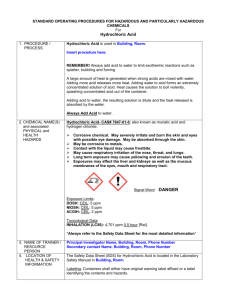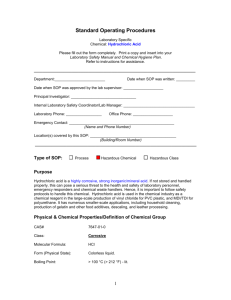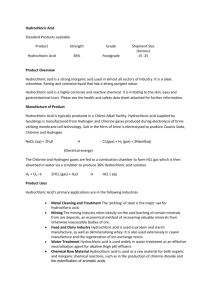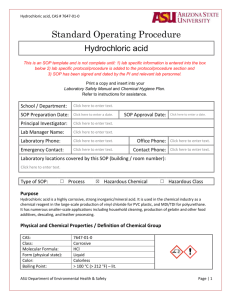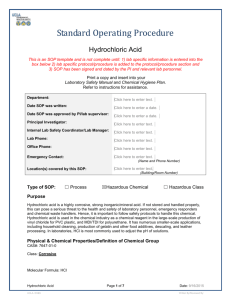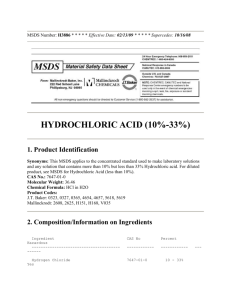Hydrochloric Acid - Texas Tech University Departments
advertisement
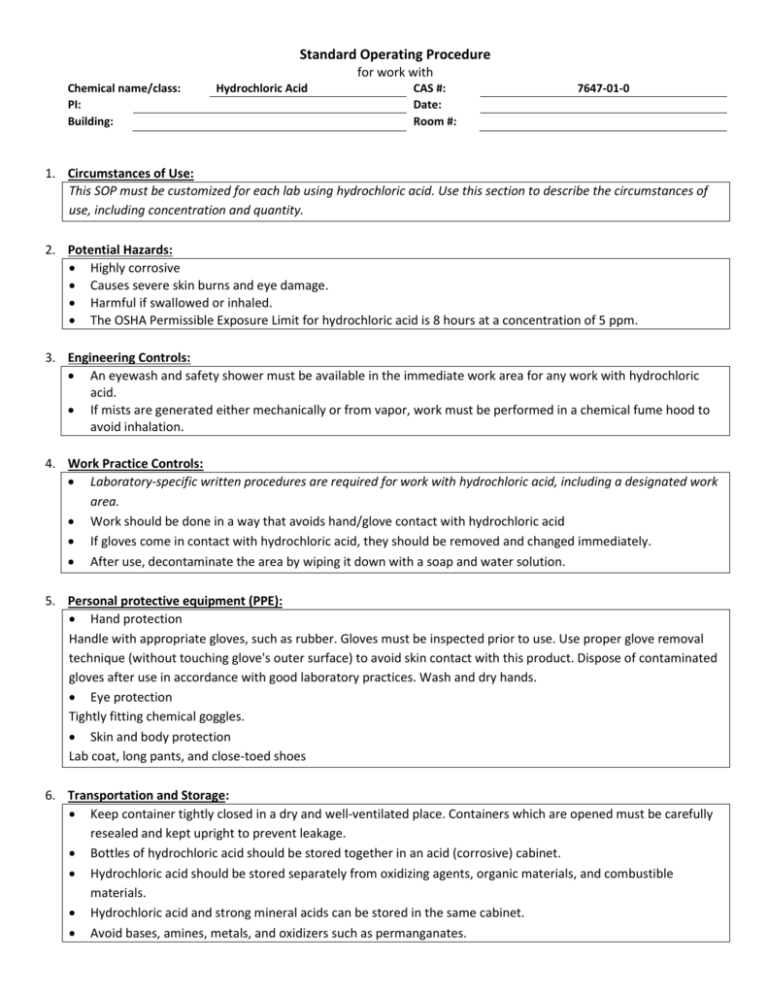
Standard Operating Procedure for work with Chemical name/class: PI: Building: Hydrochloric Acid CAS #: Date: Room #: 7647-01-0 1. Circumstances of Use: This SOP must be customized for each lab using hydrochloric acid. Use this section to describe the circumstances of use, including concentration and quantity. 2. Potential Hazards: Highly corrosive Causes severe skin burns and eye damage. Harmful if swallowed or inhaled. The OSHA Permissible Exposure Limit for hydrochloric acid is 8 hours at a concentration of 5 ppm. 3. Engineering Controls: An eyewash and safety shower must be available in the immediate work area for any work with hydrochloric acid. If mists are generated either mechanically or from vapor, work must be performed in a chemical fume hood to avoid inhalation. 4. Work Practice Controls: Laboratory-specific written procedures are required for work with hydrochloric acid, including a designated work area. Work should be done in a way that avoids hand/glove contact with hydrochloric acid If gloves come in contact with hydrochloric acid, they should be removed and changed immediately. After use, decontaminate the area by wiping it down with a soap and water solution. 5. Personal protective equipment (PPE): Hand protection Handle with appropriate gloves, such as rubber. Gloves must be inspected prior to use. Use proper glove removal technique (without touching glove's outer surface) to avoid skin contact with this product. Dispose of contaminated gloves after use in accordance with good laboratory practices. Wash and dry hands. Eye protection Tightly fitting chemical goggles. Skin and body protection Lab coat, long pants, and close-toed shoes 6. Transportation and Storage: Keep container tightly closed in a dry and well-ventilated place. Containers which are opened must be carefully resealed and kept upright to prevent leakage. Bottles of hydrochloric acid should be stored together in an acid (corrosive) cabinet. Hydrochloric acid should be stored separately from oxidizing agents, organic materials, and combustible materials. Hydrochloric acid and strong mineral acids can be stored in the same cabinet. Avoid bases, amines, metals, and oxidizers such as permanganates. 7. Waste Disposal: Handle and store wastes following the guidelines above while accumulating wastes and awaiting chemical waste pickup. Waste must be disposed of in accordance with the Texas Tech University’s Chemical Hygiene Plan. 8. Exposures/Unintended contact: Contact the principle investigator of the laboratory or Environmental Health & Safety at 742-3876 for advice on occupational chemical exposures. In the event of an actual chemical exposure notify the principle investigator and Environmental Health & Safety immediately. If skin contact occurs, immediately remove contaminated clothing and wash skin with soap and water. Seek medical attention if needed after 15 minutes of water rinsing or if a large area of the body comes in contact with hydrochloric acid. For eye exposures, immediately rinse eyes with copious amounts of water for at least 15 minutes while occasionally lifting upper and lower lids. While rinsing eyes have someone seek medical attention. If inhaled, move person to fresh air immediately. If not breathing, give artificial respiration and consult a physician. If ingested, do NOT induce vomiting. Rinse mouth with water and give large amounts of water or milk, if available. Seek medical attention immediately. 9. Spill Procedure: On Texas Tech University campus, “large” spills of hazardous materials and all mercury spills must be referred to Environmental Health & Safety at 742-3876. Small Spill: Ventilate area of spill. Remove all non-essential personnel from area. Don the appropriate PPE and use absorbent pads (some are provided in the spill kit) to clean the area. Place the pads in the accompanying yellow waste bag and contact EH&S to pick up for disposal. If necessary, neutralize spill with a suitable agent, such as powdered sodium bicarbonate. Large Spill: Do not attempt to clean up the spill. Contact Environmental Health & Safety at 742-3876. If at any time the individual does not feel comfortable cleaning up the spill, contact Environmental Health & Safety at 742-3876. 10. Training of personnel: All personnel are required to complete the online Lab Safety Training through the Texas Tech University Environmental Health & Safety website or attend a Laboratory Safety Seminar presented by Texas Tech University Environmental Health & Safety. These trainings include an introduction to general chemical safety. Furthermore, all personnel shall read and fully adhere to this SOP when handling the chemical. “I have read and understand this SOP. I agree to fully adhere to its requirements.” Last (print) First (print) TTU R Number Signature
